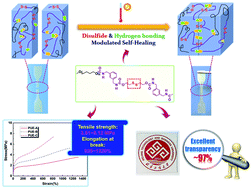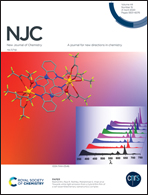A colorless, transparent and self-healing polyurethane elastomer modulated by dynamic disulfide and hydrogen bonds†
Abstract
Self-healing polyurethanes (PUs) represent a new type of functional material which are highly desirable for applications such as surface protection coatings and transparent films. However, it is still challenging to obtain self-repairable PUs with good mechanical properties and excellent optical properties. Herein, in view of molecular design, a self-healing thermoplastic polyurethane (TPU) was designed with polytetramethylene ether glycol (PTMEG) as the soft segment and aliphatic isocyanate (m-xylylene diisocyanate, XDI) and aliphatic disulfide (bis(2-hydroxyethyl)disulfide, HEDS) as the hard segment. The TPU exhibited widely tunable mechanical properties, i.e., tensile stress values of 3.51–8.12 MPa with elongation at break values of 825–1320%. The cooperation of dynamic disulfide bonds and hydrogen bonding endowed the TPU elastomer with self-healing capacity and a self-healing efficiency of about 39% at a moderate temperature. Both the amorphous phase structure and XDI chemical structure contributed to a colorless, transparent and anti-yellowing TPU film with nearly 97% transparency and long-term optical stability. The tough, colorless and transparent self-healable elastomers have wide applications in optical and protective fields, including in automotive laminated glass, flexible displays, printers, and photographic equipment cleaning scrapers.



 Please wait while we load your content...
Please wait while we load your content...